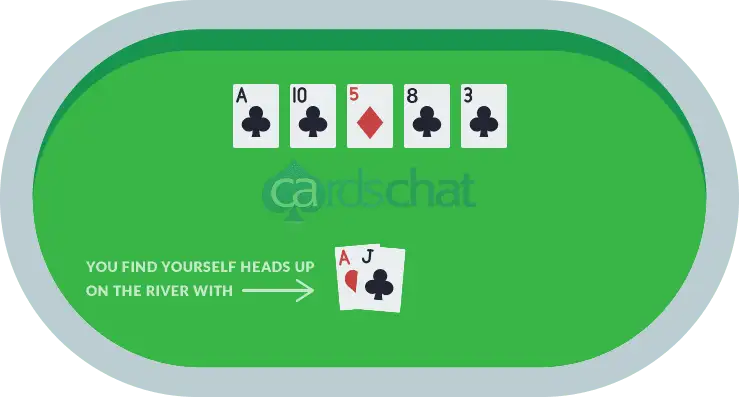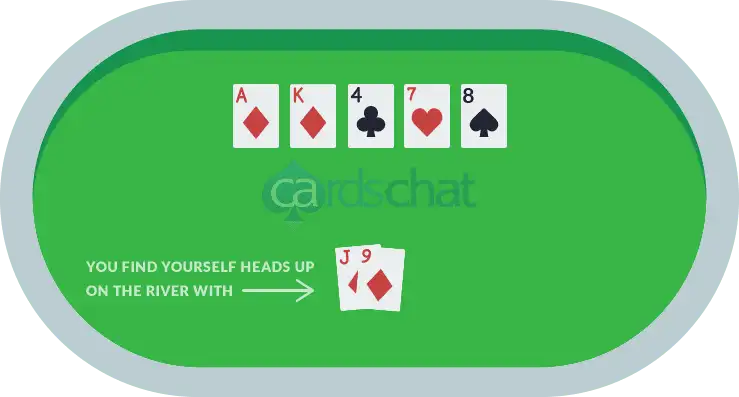Expected Value – Understanding EV in Online Poker 2024
 Reviewed by WSOP Winner Chris ‘Fox’ Wallace
Reviewed by WSOP Winner Chris ‘Fox’ Wallace
How to Calculate and Use Expected Value
Expected value helps poker players make decisions based on risk versus reward. Players use the expected value formula to quickly calculate if they should bet, check or fold. Our extensive guide below will help you to find expected value in any hand and quickly make the right call.
What is Expected Value?
In essence, “expected value” is a concept used to describe the average outcome of a given scenario that hinges on an uncertain probabilistic event.
A Simple Example
A fair coin, when flipped, has a 50% chance of coming up heads, and a 50% chance of coming up tails. Let’s say you will receive $1 if it comes up heads, and nothing if it comes up tails.
It’s clear that there is a 50% chance of winning a dollar and a 50% chance of winning nothing. The average outcome here is also fairly straightforward: you would expect, on average, to win 50 cents.
Because the probability indicates you would profit from this scenario in the long run, taking that risk would be a ‘positive EV’ (positive expected value) decision.
Positive EV
| #TRIAL | WAGER | OUTCOME | WINNINGS | PROFIT |
|---|---|---|---|---|
| 1 | $0.00 | HEADS | $1.00 | $1.00 |
| 2 | $0.00 | HEADS | $1.00 | $1.00 |
| 3 | $0.00 | HEADS | $1.00 | $1.00 |
| 4 | $0.00 | HEADS | $1.00 | $1.00 |
| 5 | $0.00 | HEADS | $1.00 | $1.00 |
| 6 | $0.00 | TAILS | $0.00 | |
| 7 | $0.00 | TAILS | $0.00 | |
| 8 | $0.00 | TAILS | $0.00 | |
| 9 | $0.00 | TAILS | $0.00 | |
| 10 | $0.00 | TAILS | $0.00 | |
| TOTAL PROFIT = | $5.00 | |||
| PROFIT / HAND = | $0.50 |
Although the 50 cents answer seems obvious here, it feels counterintuitive because you don’t ever actually get paid 50 cents: you are either given $1 or $0:
- The expected value in this example comes from running the scenario an infinite number of times
- It takes an infinite number of flips to guarantee an equal number of heads and tails
- Because the probabilities will ‘work out’ to be correct in the long run, you can use them to calculate the average outcome for the scenario
- To do this, take the probability of each potential outcome (heads or tails) and multiply it by its corresponding payout ($1 or $0)
The Expected Value Formula
For the following expected value formula, P(A) will denote the probability of event A happening, and amt(A) will denote the payout that occurs when event A happens.
EV(COIN FLIP) = P(HEADS)AMT(HEADS) + P(TAILS)AMT(TAILS)
(50%)($1)
$0.50
(50%)($0)
$0
EV(COIN FLIP) = $0.50 + $0
EV(COIN FLIP) = $0.50
Expected Value and Poker
EXAMPLE 1 – Limit Hold’em
Expected value defines the average outcome when taking into account the probability of certain events, and with so many situations where probability dictates the outcome, it stands to reason that this concept applies a lot in poker. To illustrate this, let’s look at a simple limit Hold’em example:

Your opponent has checked, and it’s your option. The pot is $100, and the big bet is $10. Should you bet?
To answer this, we’ll first have to determine how often your opponent will call, how often they will raise, and how you will fare in each of those events. Let’s assume that you somehow know their exact range and it is only Ax, where the non-ace card is a club. You think that A-9, A-7 and A-6 will call, and A-5, A-4 and A-2 will fold. A-Q with the Qc or A-K with the Kc will raise and make it two bets.
Clearly, if they make it two bets, you should always fold since you are always losing. But should you bet in the first place?
Let’s look at the EV formula, and state that situation X is the one where you bet, the opponent raises, and you fold. Situation Y is where you bet and they call. Situation Z is where you bet and they fold.
EV(BET) = P(X)AMT(X) + P(Y)AMT(Y) + P(Z)AMT(Z)
You know that each of their possible poker hands is equally likely (two aces left, times the specific other card means two combos each), and there are 8 total hands they can have. So we can quickly determine the probability of them holding each type of hand.
P(X) = 2/8 = 0.25
P(Y) = 3/8 = 0.375
P(Z) = 3/8 = 0.375
When you bet and get raised, you have lost your $10 bet. When you bet and get called, you make the $100 in the pot, plus the $10 from the call. When you bet and they fold, you just win the $100 in the middle.
EV(BET) = P(X)AMT(X) + P(Y)AMT(Y) + P(Z)AMT(Z)
AMT(X) = -$10
(0.25)(-$10)
-$2.50
AMT(Y) = $110
(0.375)($110)
$41.25
AMT(Z) = $100
(0.375)($100)
$37.50
EV(BET) = -$2.50 + $41.25 + $37.50
EV(BET) = $76.25
This seems great right away, but to know whether it’s better than checking you must also determine the EV of checking.
The probability is a little different this time because there are only two outcomes – you win at showdown, or lose.
P(WIN) = 6/8 = 0.75
P(LOSE) = 2/8 = 0.25
The payouts are different too. When you win, you win the $100 in the pot, but when you lose, you don’t lose anything additional.
AMT(WIN) = $100
AMT(LOSE) = $0
So putting this all back together, you find the EV of checking:
EV(CHECK) = P(WIN)AMT(WIN) + P(LOSE)AMT(LOSE)
(0.75)($100)
$75
(0.25)($0)
$0
EV(CHECK) = $75 + $0
EV(CHECK) = $75
As you can see this is actually fairly close, with betting having the slight edge over checking. The difference in EV of betting as compared to checking is only $1.25, or 1/8 of a big bet. This is not a huge difference so, if you have some uncertainty in your read about your opponent’s range, a check would be preferable.
For instance, if they would actually raise the 9c but you don’t think they would, you may fold incorrectly and lose the pot too often, decreasing the EV of a bet below the EV of a check.
EXAMPLE 2 – No Limit Hold’em
Let’s take a look at an example from no limit Hold’em. You’re heads up at the river with J-9s on a board of Ad Kd 4c 7h 8s, for nothing but a busted flush draw. Your opponent has checked, leaving you with the decision whether or not to bluff all in. The pot is $200, and you have $100 in your stack.

Due to how the hand played out, you think your opponent can’t have a set or flopped two pair, but they could hold A-Q to A-T, Q-Ts, or pocket nines through pocket queens.
You think that if you shove, they will fold Q-Ts and Q-Q through 9-9, but will call with their Ax hands.
Let’s look at the number of each of those hands and the resulting probability that they will call a shove:
EV(CHECK) = P(WIN)AMT(WIN) + P(LOSE)AMT(LOSE)
36
COMBINATIONS
A-Q to A-T
+
1
COMBINATION
Q-Ts
+
18
COMBINATIONS
(YOU BLOCK Jd AND 9d)
Q-Q to 9-9
=
55
TOTAL COMBINATIONS
P(CALL) = 36/55
=
0.6545
P(FOLD) = 19/55
=
0.3455
If you shove and they fold, you win the $200. If you shove and they call, you are always beat and lose your $100 stack.
EV(SHOVE) = P(CALL)AMT(CALL) V P(FOLD)AMT(FOLD)
AMT(CALL) = -$100
(0.6545) (-$100)
-$65.45
AMT(FOLD) = $200
(0.3455) ($200)
$69.10
EV(SHOVE) = -$65.45 V $69.10
The expected value of a check is actually $0 here because we never win the pot when we check it behind.
EV(CHECK) = $0
So in this spot shoving is preferable to checking, even though you get called well over 50% of the time.
This is a situation that can arise fairly often in poker – since most bets are for a pot-sized bet or less even in no limit games, you are typically laying yourself a price of better than 1:1
In this case, we lay 2:1 by risking a bet worth half the pot, so we only need it to succeed 1/3 of the time to be break even as compared to checking.
Applying Expected Value
There are a lot of deep, fundamental applications of EV poker, many of which won’t help you too much in the heat of battle but which can improve your game if you dedicate some time to study them.
However, expected value does have applications in some real-time poker situations. This is usually going to be in special cases where either:
- All the money is already all-in
- You’re faced with a decision to call all-in or fold
- You are facing a bet and are deciding whether or not to shove all-in
Anything beyond these three tends to get more complicated as you start to add more branches to the possible decision tree.
It’s still possible to do these types of calculations using software, but making them in-game in real-time is nearly impossible.
However, with some practice, it’s possible to gain a level of proficiency where you can do rough EV poker estimates for fold equity situations and river value bet spots. This requires a deep understanding of your equity, as well as the ability to do basic algebra on the fly, but estimates can get you pretty close.
The true power of expected value comes in doing off-table calculations that help you improve your intuition and get your in-game estimates closer and closer to the real expected values of various plays.
Further Reading
Learning about odds and complex mathematical concepts can be hard, but it’s something that almost all leading poker players are familiar with…even if they may sometimes forsake the moves that they ‘should’ make in favor of gut instinct.
To continue your education on odds and the mathematics of poker, check out these useful resources:
POT ODDS & IMPLIED ODDS
Our next guide in this series, this is a deeper dive into calculating pot odds, implied odds and how to apply them to the poker hand you have in front of you.
WOLFRAM MATHWORLD
This comprehensive resource covers all sorts of different mathematical concepts and how they relate to poker. It makes for some tricky reading – definitely not one to unwind with before bedtime! – but the information on the page is invaluable.
POKER ODDS CALCULATOR
If you’re not yet at the stage where you’re comfortable running calculations in your head, you can start using our odds calculator to help figure out your odds on any given hand.
Expected Value in Poker – FAQ
What is EV in Poker?
Expected Value, or EV, is used to describe the average outcome of a situation which depends on an uncertain event. In other words, EV refers to the average amount of money you could win or lose in a specific scenario. Decisions can have a positive EV or a negative EV. The more decisions you make with a positive EV, the better your results will be in the long run.